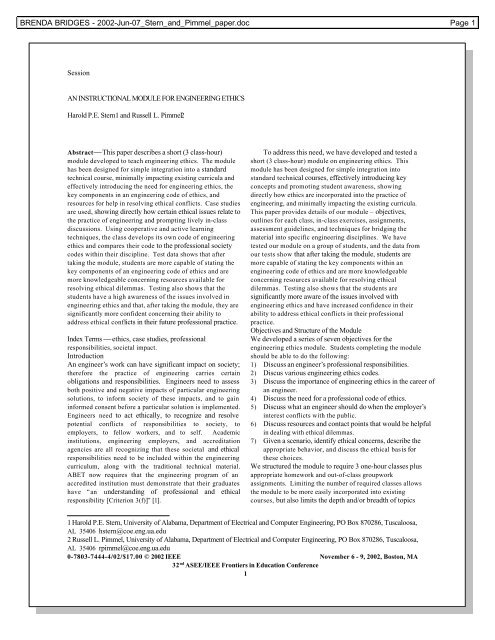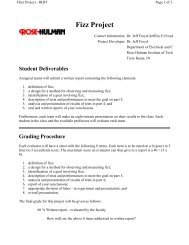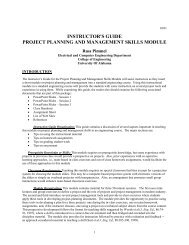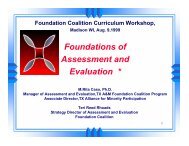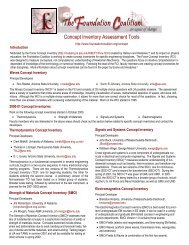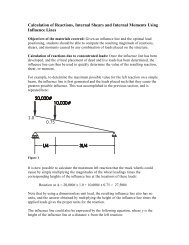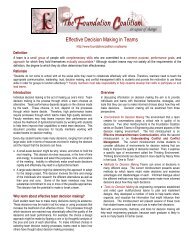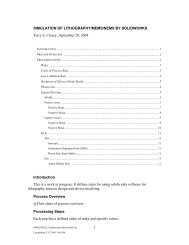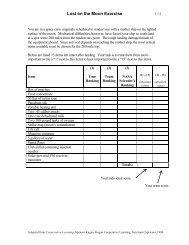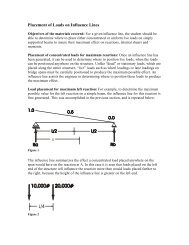Paper - Foundation Coalition
Paper - Foundation Coalition
Paper - Foundation Coalition
You also want an ePaper? Increase the reach of your titles
YUMPU automatically turns print PDFs into web optimized ePapers that Google loves.
BRENDA BRIDGES - 2002-Jun-07_Stern_and_Pimmel_paper.doc Page 1<br />
Session<br />
AN INSTRUCTIONAL MODULE FOR ENGINEERING ETHICS<br />
Harold P.E. Stern1 and Russell L. Pimmel2<br />
Abstract ⎯ This paper describes a short (3 class-hour)<br />
module developed to teach engineering ethics. The module<br />
has been designed for simple integration into a standard<br />
technical course, minimally impacting existing curricula and<br />
effectively introducing the need for engineering ethics, the<br />
key components in an engineering code of ethics, and<br />
resources for help in resolving ethical conflicts. Case studies<br />
are used, showing directly how certain ethical issues relate to<br />
the practice of engineering and prompting lively in-class<br />
discussions. Using cooperative and active learning<br />
techniques, the class develops its own code of engineering<br />
ethics and compares their code to the professional society<br />
codes within their discipline. Test data shows that after<br />
taking the module, students are more capable of stating the<br />
key components of an engineering code of ethics and are<br />
more knowledgeable concerning resources available for<br />
resolving ethical dilemmas. Testing also shows that the<br />
students have a high awareness of the issues involved in<br />
engineering ethics and that, after taking the module, they are<br />
significantly more confident concerning their ability to<br />
address ethical conflicts in their future professional practice.<br />
Index Terms ⎯ ethics, case studies, professional<br />
responsibilities, societal impact.<br />
Introduction<br />
An engineer’s work can have significant impact on society;<br />
therefore the practice of engineering carries certain<br />
obligations and responsibilities. Engineers need to assess<br />
both positive and negative impacts of particular engineering<br />
solutions, to inform society of these impacts, and to gain<br />
informed consent before a particular solution is implemented.<br />
Engineers need to act ethically, to recognize and resolve<br />
potential conflicts of responsibilities to society, to<br />
employers, to fellow workers, and to self. Academic<br />
institutions, engineering employers, and accreditation<br />
agencies are all recognizing that these societal and ethical<br />
responsibilities need to be included within the engineering<br />
curriculum, along with the traditional technical material.<br />
ABET now requires that the engineering program of an<br />
accredited institution must demonstrate that their graduates<br />
have “an understanding of professional and ethical<br />
responsibility [Criterion 3(f)]” [1].<br />
To address this need, we have developed and tested a<br />
short (3 class-hour) module on engineering ethics. This<br />
module has been designed for simple integration into<br />
standard technical courses, effectively introducing key<br />
concepts and promoting student awareness, showing<br />
directly how ethics are incorporated into the practice of<br />
engineering, and minimally impacting the existing curricula.<br />
This paper provides details of our module – objectives,<br />
outlines for each class, in-class exercises, assignments,<br />
assessment guidelines, and techniques for bridging the<br />
material into specific engineering disciplines. We have<br />
tested our module on a group of students, and the data from<br />
our tests show that after taking the module, students are<br />
more capable of stating the key components within an<br />
engineering code of ethics and are more knowledgeable<br />
concerning resources available for resolving ethical<br />
dilemmas. Testing also shows that the students are<br />
significantly more aware of the issues involved with<br />
engineering ethics and have increased confidence in their<br />
ability to address ethical conflicts in their professional<br />
practice.<br />
Objectives and Structure of the Module<br />
We developed a series of seven objectives for the<br />
engineering ethics module. Students completing the module<br />
should be able to do the following:<br />
1) Discuss an engineer’s professional responsibilities.<br />
2) Discus various engineering ethics codes.<br />
3) Discuss the importance of engineering ethics in the career of<br />
an engineer.<br />
4) Discuss the need for a professional code of ethics.<br />
5) Discuss what an engineer should do when the employer’s<br />
interest conflicts with the public.<br />
6) Discuss resources and contact points that would be helpful<br />
in dealing with ethical dilemmas.<br />
7) Given a scenario, identify ethical concerns, describe the<br />
appropriate behavior, and discuss the ethical basis for<br />
these choices.<br />
We structured the module to require 3 one-hour classes plus<br />
appropriate homework and out-of-class groupwork<br />
assignments. Limiting the number of required classes allows<br />
the module to be more easily incorporated into existing<br />
courses, but also limits the depth and/or breadth of topics<br />
1 Harold P.E. Stern, University of Alabama, Department of Electrical and Computer Engineering, PO Box 870286, Tuscaloosa,<br />
AL 35406 hstern@coe.eng.ua.edu<br />
2 Russell L. Pimmel, University of Alabama, Department of Electrical and Computer Engineering, PO Box 870286, Tuscaloosa,<br />
AL 35406 rpimmel@coe.eng.ua.edu<br />
0-7803-7444-4/02/$17.00 © 2002 IEEE November 6 - 9, 2002, Boston, MA<br />
32 nd ASEE/IEEE Frontiers in Education Conference<br />
1
BRENDA BRIDGES - 2002-Jun-07_Stern_and_Pimmel_paper.doc Page 2<br />
Session<br />
which can be discussed in class. We selected a case study<br />
approach with in-class discussions. We chose this structure<br />
for our module rather than traditional lecturing, group<br />
activity, student presentatio n, or role-playing, because we<br />
felt that with proper guidance from the instructor, this<br />
approach might provide an opportunity for more diversity of<br />
views, livelier interaction, and more critical thinking. Case<br />
studies also show directly how certain ethical issues apply to<br />
the practice of engineering.<br />
The module is organized into three 50-minute in-class<br />
instruction periods, and students are organized into 3 or 4-<br />
person groups for their out-of-class assignments. The first<br />
class period is devoted to a case study of the Ford Pinto.<br />
During the second class period the students develop their<br />
own class-wide code of engineering ethics and then compare<br />
it to the various codes within their engineering discipline.<br />
The third class period is devoted to a case study of Werner<br />
von Braun. Details of the individual class periods, including<br />
corresponding out-of-class work, key points for each of the<br />
case studies, and an organizational framework for<br />
engineering codes of ethics is given in the sections below 3<br />
Case Study #1 – The Ford Pinto<br />
Prior to the first session, students are placed in 3 or 4-person<br />
groups and are assigned to read [2 - 4], view a QuickTime<br />
movie showing a rear-end collision with a Pinto and the<br />
subsequent fire (accessible through [2]), and discuss the<br />
following series of questions within their groups:<br />
1) Is it ethical for a company, such as Ford, to perform<br />
cost-benefit analyses when lives are involved?<br />
2) As a society we often perform cost-benefit analyses<br />
involving lives. For example, we do not require<br />
overpasses to be built at all railroad crossings, even<br />
though we know that an occasional fatal collision will<br />
occur if we do not. How is this different from what Ford<br />
did?<br />
3) Do you think that the public was adequately informed<br />
concerning the dangers of the Pinto?<br />
4) Could it be possible that upper management at Ford did<br />
not understand the engineering issues involved? What<br />
was Lee Iacocca’s technical background?<br />
5) Suppose you are an engineer at Ford and you have just<br />
discovered the Pinto’s gas tank problems. You discuss<br />
the situation with your manager and he tells you he<br />
doesn’t see a problem. What, if anything, do you do<br />
next?<br />
6) Ford designed the Pinto to satisfy all then-existing legal<br />
requirements for safety. Do they have a higher<br />
obligation? Does it matter that, during the design, Ford<br />
was successfully lobbying the US government to not<br />
impose more stringent safety requirements?<br />
7) Should a profession impose ethical obligations which are<br />
more stringent than legal obligations? If so, why? If so,<br />
how should they be enforced?<br />
In order to ensure that the students read the material and<br />
discuss the questions prior to the first clas s, the instructor<br />
may announce that he/she will be giving a short quiz at the<br />
beginning of the class period. A sample quiz is included in<br />
the instructor’s guide.<br />
During the class period, the instructor leads the class in<br />
a discussion of the above questions (the instructor’s guide<br />
provides a large quantity of information and helpful<br />
comments to assist the instructor in guiding the class<br />
discussion). The questions are designed to elicit the<br />
following key points and address the indicated course<br />
objectives:<br />
a) An engineer has a responsibility to employ reasonable<br />
engineering practices concerning the safety of the<br />
products he or she develops. (Objective #1)<br />
b) As a society, we elect to take certain risks because of the<br />
possible benefits we may gain. For example, we choose<br />
to have a 70 mph speed limit on highways rather than<br />
drive at 20 mph, which would reduce the number of<br />
accidents, because the higher speed limit allows us to<br />
reach our destinations much faster. The key to society<br />
taking these risks is that the members of society give an<br />
informed consent. (Objectives #5 and #7)<br />
c) Because of their technical background, engineers are more<br />
likely to grasp the possible societal and safety<br />
implications of a technology or a product than either<br />
company management or the general public. An<br />
engineer has the responsibility to inform management of<br />
possible safety hazards in products he or she is<br />
developing. If management does not respond<br />
appropriately, the engineer has a responsibility to work<br />
within her/his company to make sure that his/her<br />
concerns are known and given due consideration. The<br />
engineer may also have a responsibility to inform the<br />
public (i.e., to blow the whistle). (Objectives #4 and #7)<br />
3 Interested readers can preview all material for our module, including the instructor’s guide, assignment sheets, and<br />
appropriate audiovisual material at http://www.ece.ua.edu/faculty/pimmel/public_html/ec2000-modules. Electronic copies of<br />
the module material are also available by directly contacting the authors. The above URL provides previews for a total of 15<br />
modules developed by various educators as part of the <strong>Foundation</strong> <strong>Coalition</strong>, with support from the Engineering Education<br />
Program at the National Science <strong>Foundation</strong> under award number EEC9802942. The other fourteen modules are computational<br />
skills, design skills, experimental skills, modeling skills, societal impact of engineering, knowledge of contemporary issues,<br />
problem solving, project management, lifelong learning, teaming, time management, graphical communication, oral<br />
communication, and written communication.<br />
0-7803-7444-4/02/$17.00 © 2002 IEEE November 6 - 9, 2002, Boston, MA<br />
32 nd ASEE/IEEE Frontiers in Education Conference<br />
2
BRENDA BRIDGES - 2002-Jun-07_Stern_and_Pimmel_paper.doc Page 3<br />
Session<br />
d) Engineers have ethical responsibilities concerning the<br />
public’s safety which are more stringent than legal 3)<br />
obligations. The technical complexity of issues within<br />
our profession, coupled with rapid changes in<br />
technology, mean that the public cannot be protected<br />
through explicit laws alone, since the laws cannot<br />
always be current enough or provide sufficient detail to<br />
handle all relevant situations and still encourage<br />
responsible innovation. Development of and adherence<br />
to a professional code of ethics is therefore necessary.<br />
Enforcement of the code is often accomplished through<br />
peer pressure and a civil court system which uses<br />
professional peers to advise juries concerning<br />
reasonable engineering practices . (Objectives #5 and<br />
#7)<br />
4)<br />
Additional concepts include an engineer’s responsibility to<br />
his or her employer, gauging a company’s culture to<br />
determine its commitment to public safety, and determining<br />
when whistleblowing is acceptable or even imperative.<br />
There are many safety-related cases which are newer<br />
than the Ford Pinto (in particular the cases of the vulnerable<br />
Chevy S10 saddlebag-style gas tanks and the problems with<br />
Firestone tires on the Ford Explorer), and these newer cases<br />
may be more familiar and feel more contemporary to the<br />
students. Nevertheless, we chose the Ford Pinto case<br />
because it has the following unique features.<br />
1)<br />
The cost-benefit analysis was clearly spelled out and<br />
explicitly performed. In an internal memorandum, Ford<br />
used a $200,000 per life lost figure (from an NHTSA<br />
study) to justify not repairing the problem. Students<br />
should at first be appalled that such an analysis was<br />
performed, then, through discussion of the first and<br />
second questions above, they should see that as a<br />
society we often perform cost-benefit analyses<br />
involving lives. Differentiation between a company<br />
analysis and a societal analysis should help students<br />
understand the societal impact of engineering, to<br />
appreciate the need to inform society of the technical<br />
consequences of various engineering solutions, and to<br />
gain an informed societal consent prior to<br />
implementation.<br />
Upper management at Ford, in particular Lee Iacocca, had a<br />
technical background (Bachelor’s in Industrial<br />
Engineering from Lehigh University, Master’s in<br />
Engineering from Princeton). This robs the student of<br />
any comfortable feeling that the problem may only<br />
have occurred because management did not<br />
understand the technical issues or have the training<br />
necessary to perform a sound scientific assessment.<br />
The instructor should still note that in many cases<br />
management does not have a technical background<br />
and that part of an engineer’s ethical responsibility is<br />
to make sure that management understands the<br />
technical issues.<br />
The purely legal mechanisms of regulation and the criminal<br />
justice system were both used in the Ford Pinto case,<br />
and were insufficient to safeguard the public. As part<br />
of the pre-class reading assignment, students are<br />
informed of the State of Indiana’s negligent homicide<br />
trial of Ford4, which ended in acquittal, possibly due to<br />
the high burden of proof rightfully required in a<br />
criminal proceeding. As also discussed in the assigned<br />
pre-class reading (and in Question #6), establishment<br />
of regulations is a slow, drawn-out procedure which<br />
can be either insufficiently responsive to safeguard the<br />
public or else can be over-encompassing and stifling to<br />
responsible innovation. The Ford Pinto case shows<br />
that criminal law and regulations alone are<br />
inappropriate to balance the public’s interests in safety<br />
and responsible innovation, hence one of the needs for<br />
ethical obligations.<br />
Developing a Code of Engineering Ethics<br />
This second session addresses Objectives #2, #4, and #6.<br />
As a pre-assignment for the second session, each student<br />
group is tasked with developing its own engineering code<br />
of ethics. The students are specifically told NOT to read<br />
any professional organization’s codes prior to doing their<br />
work, but to develop their own codes based on the first<br />
session’s case study (concerning large, societal issues) and<br />
based on their own experiences (concerning smaller,<br />
4 The following paragraph is included in the student’s reading assignment:<br />
“Some legal background: Most of the lawsuits against Ford were civil suits for actual and punitive damages, but one case<br />
involved criminal charges. In Indiana a rear-end collision between a van and a Pinto caused a fire which killed three teenage<br />
girls in the Pinto. Ford was subsequently tried in Indiana on the criminal charge of negligent homicide (this is the trial<br />
mentioned in the … web page). There were no accompanying civil suits for this particular incident because, at the time,<br />
Indiana law severely limited the amount of damages which a parent could recover for the death of a minor child (no punitive<br />
damages were allowed and actual damages were limited to the lost wages which the minor might have earned in the time<br />
between his/her death and age 18). Many argue that Ford was acquitted of the negligent homicide charge because the<br />
standard of proof in a criminal charge is much higher than the standard of proof in a civil charge (reasonable doubt vs. a<br />
preponderance, or balancing, of the evidence). The most damaging civil case against Ford was Grimshaw vs. Ford, a<br />
California case in which a jury awarded $150 million in punitive damages (later reduced to $6 million on appeal).”<br />
0-7803-7444-4/02/$17.00 © 2002 IEEE November 6 - 9, 2002, Boston, MA<br />
32 nd ASEE/IEEE Frontiers in Education Conference<br />
3
BRENDA BRIDGES - 2002-Jun-07_Stern_and_Pimmel_paper.doc Page 4<br />
Session<br />
personal issues). During the second session the instructor<br />
leads a 35-minute discussion to develop a class-wide<br />
consensus for a code, using contributions from each group.<br />
The instructor then summarizes the discussion, noting that<br />
all the suggested items can be divided into classes of<br />
responsibilities — responsibilities to society, to an employer,<br />
to fellow workers, and to self, and that ethical problems arise<br />
when there are conflicts between responsibilities to two or<br />
more of the above classes. These observations provide a<br />
general structure for ethical codes and give students a way<br />
to analyze and resolve ethical problems. The instructor then<br />
provides copies of ethical codes from appropriate<br />
professional societies, reinforces the observations about<br />
how codes are organized, and relates the professional<br />
society ethical codes with the code developed in class. The<br />
instructor also discusses resources (professional societies,<br />
web pages, journals, books, and hotlines) which can help<br />
engineers when they are confronted with particular ethical<br />
issues (these resources are listed in the instructor’s guide).<br />
Case Study #2 – Werner Von Braun<br />
The third session is a case study involving Wernher von<br />
Braun, with students having read a series of web pages and a<br />
book review [5-12] as their pre-class assignment. The first<br />
few web pages praise von Braun’s technical achievements<br />
and downplay his involvement with the Nazis during World<br />
War II. Later web pages discuss his joining the SS, his<br />
knowledge of the concentration-camp-like conditions at the<br />
facilities where the V2 rockets were produced, and the<br />
damage to civilian population centers caused by the V2.<br />
Taken as a whole, the web pages attempt to balance von<br />
Braun’s actions during World War II with his post World<br />
War II attitude and his work at NASA. After completing<br />
their reading, the student groups are asked to discuss the<br />
following questions among their members prior to class:<br />
1) What do you believe motivated von Braun to work for the<br />
German military (as early as 1934)? Do you think that<br />
Von Braun believed in the Nazi cause?<br />
2) What do you believe motivated von Braun to come to<br />
America after the war? Do you think that von Braun had<br />
patriotic feelings for the US?<br />
3) Consider Tom Lehrer’s lyrics concerning von Braun [9]:<br />
“Don’t say that he’s hypocritical<br />
Say rather that he’s apolitical<br />
‘Once the rockets are up who cares where they come<br />
down?,<br />
That’s not my department,’ says Wernher Von Braun”<br />
Do you believe these lyrics are an accurate assessment<br />
of Von Braun’s attitudes?<br />
4) Do you think it is ethical for an engineer to develop a<br />
product (or technology) and not care how it will be<br />
used?<br />
5) What do you believe motivated Von Braun to work for the<br />
Nazis and then come to America?<br />
Needless to say, this is an extreme case, but do you<br />
believe that an engineer has any responsibility for<br />
ensuring safe and humane working conditions for<br />
laborers and co-workers?<br />
Do you believe that an engineer or scientist’s technical<br />
contributions should be assessed independently of his<br />
or her behavior?<br />
Do you believe that history has fairly judged Von Braun?<br />
Do you believe that the US government acted ethically<br />
6) Comment on the use of slave labor at Pennemunde.<br />
0-7803-7444-4/02/$17.00 © 2002 IEEE November 6 - 9, 2002, Boston, MA<br />
32 nd ASEE/IEEE Frontiers in Education Conference<br />
4<br />
8)<br />
9)<br />
10)<br />
concerning Von Braun?<br />
As with the Ford Pinto case study, the instructor has the<br />
option of giving a short quiz at the beginning of the class<br />
period.<br />
During the class period, the instructor leads the class in<br />
a discussion of the above questions (again, the instructor’s<br />
guide supplies additional information). The questions are<br />
designed to elicit the following key points and address the<br />
indicated course objectives:<br />
1) An engineer’s work can have a very significant<br />
impact on society. (Objectives #1, #3, and #5)<br />
2) It is unethical for an engineer to develop a product (or<br />
technology) not caring about how it will be used or<br />
about its impact on society. An engineer cannot divorce<br />
himself or herself from the societal impact of his or her<br />
work. [Note: There is much evidence to support an<br />
argument that von Braun did not sufficiently care how<br />
the technology he helped develop for Germany was<br />
being applied. The class discussion produced here, of<br />
course, will not definitively answer the question of von<br />
Braun’s motivations and concerns, but it should be able<br />
to use arguments on both sides to address the larger<br />
issue.] (Objectives #1 and #5)<br />
3) It is unethical for an engineer to exploit unfair labor<br />
conditions to develop a product or technology.<br />
(Objectives #1 and #5)<br />
4) Society and history will often credit an engineer for his<br />
or her technical accomplishments without holding the<br />
engineer responsible for his or her behavior. Such<br />
“hero-making” is wrong. (Objective #1)<br />
5) Governments can behave unethically. This does not<br />
excuse unethical behavior on the part of the engineer.<br />
[Note: This issue needs to first be addressed in the<br />
context of the ethics of the Nazi government. If the<br />
instructor wishes, she or he can als o focus the question<br />
on the ethics of the post-World War II U.S. government,<br />
about which there is considerable controversy and<br />
honest difference of opinion, particularly when one<br />
views the events in the context of the Cold War. If this<br />
issue is examined, the instructor needs to remind the<br />
class that the purpose of the ensuing class discussion is<br />
not to definitively justify or condemn the government’s<br />
actions toward von Braun, but rather to use arguments<br />
on both sides to address the larger issue.]
BRENDA BRIDGES - 2002-Jun-07_Stern_and_Pimmel_paper.doc Page 5<br />
Session<br />
6) Ethical mistakes can compound. You can start with a<br />
small error in judgement which will later precipitate a<br />
larger error in judgement, etc. The way to avoid the<br />
“slippery slope” is to make proper ethical judgements in<br />
the first place. (Objectives #1, #3, and #7)<br />
Wernher von Braun is an especially good case study for<br />
students here at the University of Alabama. Many of our<br />
students co-op in Huntsville, where von Braun worked for<br />
the NASA Marshall Space Flight Center.<br />
Increased Confidence<br />
In an evaluation program, we taught the engineering ethics<br />
module in a classroom setting with a faculty member, other<br />
than the developer, as teacher. The module was taught<br />
during a standard 50-minute period on a Monday,<br />
Wednesday, and Friday schedule to ten students5. The<br />
students were randomly selected from a group of paid<br />
volunteers after screening for schedule conflicts. The overall<br />
group contained 65% seniors, 25% juniors, and 10%<br />
sophomores. In this population, 45% had a GPA above 3.0<br />
while 55% had GPAs between 2.0 and 3.0; 61% had one or<br />
more coop or intern experiences, while 39% had none. In<br />
response to a question about their formal training in<br />
engineering ethics, 48% indicated that they had no<br />
experience, 36% indicated experience in one or two classes,<br />
and 16% indicated experience in three or more classes.<br />
Before teaching the module, we asked the students to assess<br />
their confidence in their ability to complete tasks<br />
representative of the module’s learning objectives (listed on<br />
the first page of this paper). We created a list of statements<br />
and asked the students to indicate their confidence for each<br />
statement using a five-valued scale (i. e., 1 – “Strongly<br />
Disagree”, 2 – “Disagree”, 3 – “Neutral”, 4 – “Agree”, and<br />
5 – “Strongly Agree”). We created the list of statements by<br />
converting each learning objective into one and only one<br />
task statement so that there was a one-to-one<br />
correspondence between the modules’ learning objectives<br />
and students’ confidence statements. For example, Objective<br />
#3, “Students should be able to discuss the importance of<br />
engineering ethics in the career of an engineer” became “I<br />
am confident that I can discuss the importance of<br />
engineering ethics in the career of an engineer”. After the<br />
module was completed, students were again asked t o rate<br />
their confidence in being able to achieve each of the<br />
module’s objectives.<br />
The data for the ethics module is given in Table 1. The<br />
numbers in the first column correspond to the numbering<br />
used to list the module’s objectives on the first page of this<br />
paper. For example, in their pre-module test, the students<br />
gave a 3.4 rating to the statement “I am confident that I can<br />
discuss resources and contact points that would be helpful<br />
in dealing with ethical dilemmas”, corresponding to<br />
Objective #6. Table 1 shows a significant increase in the<br />
students’ confidence to achieve each objective of the ethics<br />
module.<br />
TABLE 1. PRE- AND POST-MODULE CONFIDENCE IN<br />
ACHIEVING ENGINEERING ETHICS OBJECTIVES<br />
Objective Premodule Postmodule Improvement<br />
1 3.5 4.4 + 0.9<br />
2 3.2 4.5 + 1.3<br />
3 3.8 4.4 + 0.6<br />
4 3.8 4.5 + 0.7<br />
5 3.7 4.5 + 0.8<br />
6 3.4 4.5 + 1.1<br />
7 3.6 4.3 + 0.7<br />
Increased Awareness<br />
Students were also asked to assess their awareness of ethical<br />
issues by rating, on the same 1 – 5 scale, their opinion of the<br />
importance to a graduating engineer of each of the seven<br />
objectives both before and after they took the module. As<br />
with the confidence measurements, we asked the students to<br />
rate a series of questions which had a one-to-one<br />
correspondence with the objectives (the question, for<br />
example, for Objective #6 was “It is important that graduate<br />
engineers can discuss resources and contact points that<br />
would be helpful in dealing with ethical dilemmas.”) The<br />
results, shown in Table 2, indicate that the students had a<br />
high awareness of the importance of ethical issues to<br />
engineering before the module began, but that the module<br />
did not increase their awareness. (Cynically speaking, this<br />
advance awareness may simply be due to the student’s<br />
advance knowledge of the title of the module.)<br />
TABLE 2. PRE- AND POST-MODULE ASSESSMENT OF<br />
IMPORTANCE OF ENGINEERING ETHICS OBJECTIVES<br />
Objective Premodule Postmodule Improvement<br />
1 4.5 4.5 0<br />
2 4.3 4.4 + 0.1<br />
3 4.4 4.5 + 0.1<br />
4 4.4 4.5 + 0.1<br />
5 4.5 4.4 - 0.1<br />
6 4.3 4.4 + 0.1<br />
7 4.5 4.3 - 0.2<br />
Incre ased Competence<br />
Using another student group (our Spring 2002 Senior Design<br />
class, where the ethics module was taught by the first<br />
author) we administered a pre- and post-module test<br />
consisting of two questions:<br />
1) Develop a series of guidelines to help an engineer make sure<br />
5 We acknowledge that this is a small group of students, and we advocate further testing.<br />
0-7803-7444-4/02/$17.00 © 2002 IEEE November 6 - 9, 2002, Boston, MA<br />
32 nd ASEE/IEEE Frontiers in Education Conference<br />
5
BRENDA BRIDGES - 2002-Jun-07_Stern_and_Pimmel_paper.doc Page 6<br />
Session<br />
that he or she is acting ethically in various professional<br />
situations.<br />
3) List resources that an engineer can consult if he or she has<br />
questions concerning professional ethics.<br />
The first question, specifically left open-ended, was<br />
designed primarily to assess our success in achieving<br />
Objective #1, and the second question was designed to<br />
assess achievement of Objective #6. The post-test was<br />
administered unannounced during a class period two days<br />
after completion of the ethics module. Fourteen students<br />
took both the pre-module and post-module tests.<br />
The tests were graded by a third party, with the pre- and<br />
post-module tests intermixed to remove any grading bias (our<br />
identifying mark was not visible to the grader). We<br />
instructed the grader to examine the responses to the first<br />
question and to determine which of the four responsibilities<br />
(society, employer, others, and self) were addressed in the<br />
student’s answer. For the second question, we asked the<br />
grader to identify the number of separate resources listed<br />
and categorize as zero, one, two, or more than two.<br />
Evaluation of the first test question is shown in Table 3.<br />
The module significantly increased recognition of<br />
responsibilities to others and moderately increased<br />
recognition of responsibilities to society and to self.<br />
Recognition of responsibility to an employer was slightly<br />
reduced – the authors believe this may be due to the<br />
emphases in the case studies. To address this issue, the<br />
questions in the Ford Pinto case (and the instructor’s guide)<br />
are being modified to further stress the engineer’s<br />
responsibility to try to resolve ethical issues within the<br />
company internally before whistleblowing. Table 3 can also<br />
be interpreted to show that after taking the module the<br />
students better understand the concept of ethical problems<br />
arising from conflicting responsibilities – pre-module<br />
answers listed an average of 2.07 competing responsibilities,<br />
while post-module answers listed an average of 2.57<br />
competing responsibilities.<br />
TABLE 3. PRE- AND POST-MODULE IDENTIFICATION OF<br />
CONFLICTING RESPONSIBILITIES<br />
Responsibility<br />
Society Employer Others Self<br />
Pre-module 8 9 3 9<br />
Post-module 10 7 8 11<br />
Difference +2 -2 +5 +2<br />
Table 4 shows the number of separate resources the<br />
students were able to identify for help in resolving ethical<br />
issues. Prior to the module, 28% of the students were only<br />
able to identify a single resource, but after the module 93%<br />
were able to identify three or more resources. We believe<br />
that Table 4 shows positive achievement of Objective #6.<br />
TABLE 4. PRE- AND POST-MODULE LISTING OF HELPFUL<br />
RESOURCES<br />
No. of Resources<br />
More<br />
than 2<br />
Identified 0 1 2<br />
Pre-module 0 4 1 9<br />
Post-module 0 0 1 13<br />
Conclusions<br />
We have developed a short, 3-class-hour module for<br />
engineering ethics which can be integrated into a standard<br />
technical course. The module, which includes case studies<br />
and the development of a code of ethics, uses cooperative<br />
and interactive learning techniques and effectively<br />
introduces the need for engineering ethics, the key<br />
components in an engineering code of ethics, and resources<br />
available to help resolve ethical issues. The module includes<br />
an instructor’s guide, which provides objectives, outlines for<br />
each class, in-class exercises, assignments, assessment<br />
guidelines, and techniques for bridging the material into<br />
specific engineering disciplines.<br />
Test data shows that after taking the module, students<br />
are more capable of stating the key components of an<br />
engineering code of ethics and are more knowledgeable<br />
concerning resources available for resolving ethical<br />
dilemmas. Testing also shows that the students are aware of<br />
the issues involved with engineering ethics and have<br />
increased confidence in their ability to address ethical<br />
conflicts in their professional practice.<br />
Acknowledgments<br />
This work was supported by the Engineering Education<br />
Program of the National Science <strong>Foundation</strong> under Award<br />
Number EEC-9802942. We thank Lee Stern for grading the<br />
competency tests and are also grateful for the reviewers’<br />
helpful comments.<br />
References<br />
Accreditation Board for Engineering Technology, Inc.,<br />
“Criteria for Accrediting Engineering Programs”, effective for<br />
evaluations during the 2000-2001 accreditation cycle,<br />
November 1, 1999.<br />
Dowie, Mark, “Pinto Madness” Mother Jones, 1977,<br />
www.mojones.com/mother_jones/SO77/dowie.html.<br />
Larsen, Suzie, “Safety Last”, Mother Jones, 1977,<br />
http://www.motherjones.com/mother_jones/SO77/la rsen.html<br />
.<br />
Tulsky, Fredric, “Shades of Pinto”, Mother Jones, 1994,<br />
http://www.motherjones.com/mother_jones/JF94/tulsky.html<br />
NASA Marshall Space Flight Center, “Wernher von Braun”,<br />
http://liftoff.msfc.nasa.gov/Academy/History/vonBraun/vonBraun.html<br />
Alabama Academy of Honor, biography of inductee Wernher<br />
von Braun,<br />
http://www.archives.state.al.us/famous/academy/ahome.html<br />
Stahlbrandt, Bo, “The V2”, 1999,<br />
http://stahlbrandt.com/html/history/v1_v2_technical.html<br />
0-7803-7444-4/02/$17.00 © 2002 IEEE November 6 - 9, 2002, Boston, MA<br />
32 nd ASEE/IEEE Frontiers in Education Conference<br />
6
BRENDA BRIDGES - 2002-Jun-07_Stern_and_Pimmel_paper.doc Page 7<br />
Session<br />
Hunt, Linda, “NASA’s Nazis”,<br />
http://dept.english.upenn.edu/~afilre is/Holocaust/nasanazis.html<br />
Lerher, Tom, “Werner von Braun”, Reprise Records, 1965.<br />
Piszkiewicz, Dennis (1995), The Nazi Rocketeers, Dreams of<br />
Space and Crimes of War, Praeger, Westport, CT ISBN 0-<br />
275-95217-7.<br />
BenThere.com, “Germany”, 1999,<br />
http://www.benthere.com/Travel/Europe/Germany/Germanytxt11.html<br />
Murphy, Richard, “Survivors of V2 Nazi Slave Camp Mark<br />
Liberation”, 1999,<br />
http://www.nizkor.org/hweb/camps/buchenwald/press/reuter<br />
s-040395.html<br />
0-7803-7444-4/02/$17.00 © 2002 IEEE November 6 - 9, 2002, Boston, MA<br />
32 nd ASEE/IEEE Frontiers in Education Conference<br />
7


